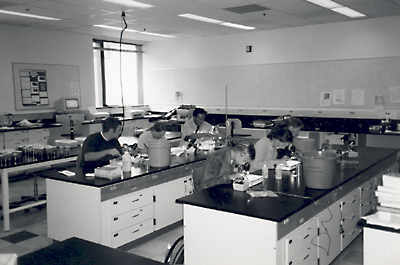 |
Using pitfall trapping to discern arthropod abundance and
diversity pm associated with desert perennial shrubs varying in size
and type

Roland Frayne, Kyle Fujii, and Heather Pedersen
Summer Session 2001 Field
Biology Course, BIOL 417a Department of Biology
Western Washington University
Bellingham, WA 98225
Introduction
- Pitfall trapping is one of the most effective techniques used to measure the diversity and abundance of arthropods available as food for desert lizards.
- Pitfall traps were placed under the two most abundant perennial shrubs found in the Alvord Desert: Basin Big Sagebrush (Artemesia tridentata) and Greasewood
(Sarcobatus vermiculatus). Two sizes (medium and large) of each shrub were used to examine the effects of shrub size on arthropod diversity and abundance.
- Two pitfall traps were placed under medium-sized shrub while four pitfall traps were placed under large- sized shrubs. Four groups of four
pitfall were also used in bare areas and, thus, were used as a control when comparing arthropod abundance and diversity in vegetative vs. non-vegetative sites.
- Neighboring shrubs within 2m from the center of the pit-trapped shrubs were assumed to be close enough to influence the abundance and diversity of arthropod in the trapped plants. Therefore, measurements of neighboring shrubs within .5m and 2m were noted and mapped.
- Pit-trapped shrubs whose 2m radii overlapped were considered as patches and analyzed to examine its influence on arthropod abundance.
- Pitfall traps were collected at the end of six consecutive 24-hour periods
during the second week of July, 2001, and all contents were brought back to Western Washington University for processing.
Back To Top
Hypotheses
- Larger perennial shrubs should harbor a greater diversity and abundance of arthropods than smaller perennial shrubs.
- There should be consistent differences in arthropod diversity and abundance among shrubs of the same size but different species.
- Arthropods should be present in greater numbers in shrubs whose neighboring shrubs within a given radius have a greater percent ground cover.
Back To Top
Materials and Methods
2
study site was subdivided into 10x10m plots using a line-transect method.
K-means clustering function in SYSTAT was used on previously collected data for Sagebrush and Greasewood to determine standardized plant sizes. Medium shrub size ranged from 5,000cm2 to 6,500cm2, while large sized shrubs ranged from 10,000cm2 to 13,000cm2.
Pitfall traps consisted of an average sized soup can (6.5-cm in diameter) with an inner plastic cup for ease of collection. They were buried near the base of the selected shrub to the point where the lip of the cans were level with the substrate and filled with propylene glycol to 1/3 their volume.
To assess neighboring shrubs, two radii sweeps were done. A 2m sweep from the center of the selected shrub was done with all shrubs within the 2m measured (length, width, height and distance from perimeter of selected shrub to perimeter of neighboring shrub) and mapped. A .5m sweep was also done from the perimeter of the selected shrub with its measurements noted and mapped.
Pitfall traps that were less than 3.7 m from each other were considered close enough to contribute to a patch effect on arthropod abundance. These shrubs were noted and later analyzed to see if in fact patches affected arthropod abundance.
Back To Top
Discussion
- Larger shrubs contain a greater abundance of arthropods when compared to medium shrubs. However, when comparing diversity, there is no significant difference between large and medium shrubs.
- When comparing arthropod distribution between species, no one shrub consists of more arthropods than the other. However, Greasewood harbors a greater diversity than Sagebrush.
- Arthropod abundance was greater when neighboring plants 0.5m from the perimeter from the selected shrub had a greater percent ground cover.
Back To Top
 Acknowledgments
Acknowledgments
The pitfall trap group would like to thank all that assisted us in our experiment. We would especially like to thank Roger Anderson for all his help and support during the last six weeks. Thank you for sharing your wisdom about pitfall trapping. We would also like to thank our two graduate TA's John Steffen and David Waltz, for their help in the field and with analyzing our data. Lastly, we would like to thank the WHOLE class for helping us in the field and back here at Western. If it weren't for all of you guys, we would probably still be here trying to classify our arthropods. Again, thank you to everyone!!
Back To Top
Home Course Description Course Application Practical Information Class Projects Photo Gallery
|
 |

